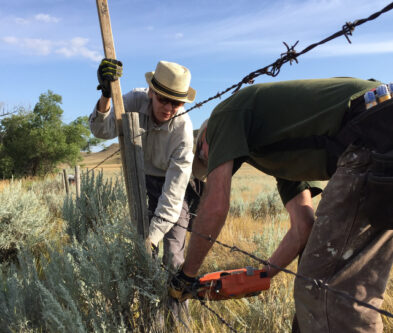Volunteers helping pronghorn overcome migration barriers
By Justin Sibbet - Lethbridge Herald Local Journalism Initiative Reporter on July 10, 2024.
 Submitted photo -
Workers remove an old barbed wire line prior to installing a new 'barb-less' wire to allow pronghorn to crawl underneath.
Submitted photo -
Workers remove an old barbed wire line prior to installing a new 'barb-less' wire to allow pronghorn to crawl underneath.LETHBRIDGE HERALDjsibbet@lethbridgeherald.com
Pronghorn are a staple of southern Alberta, yet the animal faces significant migration challenges every year in the region.
T.J. Schwanky, wildlife projects facilitator with the Alberta Wildlife Federation, says fencing designed to keep cattle and other animals in, also doubles as a barrier to pronghorns.
“The pronghorn much prefer to crawl under fences and the vast majority of them won’t jump a fence, so if they hit a barrier they can’t crawl under, sometimes they have to go for miles to get around,” said Schwanky.
“It’s a real impediment to their migration.”
He says the solution to helping these iconic mammals is quite straightforward, yet it takes a lot of work and dedication from volunteers.
“The simplest (solution) was to just raise that bottom layer (of a barbed wire fence) up to 18 inches,” said Schwanky.
“That allows a pronghorn to cross virtually anywhere in a fence line.”
Unfortunately, he says raising the barbed wire proved only moderately successful, with the animals still facing challenges and injury.
“The (pronghorn) still get a lot of scratches and wounds on their back from the barbs because it’s still a fairly tight fit underneath.”
As a result, Schwanky says the new objective of this program is to replace the bottom wire along fence lines to ensure safer passage for the animals.
“We actually put smooth wire on. It’s called ‘barbless barbed wire’ and it’s exactly the same thing as barbed wire expect there’s no barbs on it,” said Schwanky. “It’s kind of a win-win for everybody.”
He says the work required to transition this wire is time consuming and far from free. The Alberta Wildlife Federation does not receive government funding, according to Schwanky.
“We have between 10 and 16 volunteers on every project,” said Schwanky.
“We don’t get any money from government, but we do get money from several conservation groups.”
He says this work is important for the ease of mobility for the pronghorns, but the animal also provides very little in the way of negativity as well, making the work even more valuable.
“They’re just kind of a neat animal to see out there and they do very little damage to agricultural fields,” said Schwanky.
“I would say the vast majority of farmers and ranchers are very wildlife friendly and very concerned about wildlife.”
In a press release from July 3, the Alberta Wildlife Federation says this program is a collaborative effort that will help maintain the independence of pronghorns in Alberta.
“This project is a great example of how private landowners and hunters can work together to secure the future for one of Alberta’s keystone species. Pronghorn are at the northern extent of their range in Alberta and are highly migratory and must often move great distances to avoid severe weather. By removing barriers to this migration, the future of pronghorn in Alberta is bright.”
This summer, the Alberta Wildlife Federation has three main events scheduled to work on refencing areas in southern Alberta. The first event occurs on the weekend of July 20 in Manyberries. The second event is in Orion during the weekend of Aug. 17 and the final event will be on the weekend of Sept. 21 in Milk River.
Those looking to get involved in this program, either as a landowner or a volunteer, are encouraged to reach out to Schwanky at tj-afga@shaw.ca.
23-22


